Just imagine you are with your friends at a table exchanging stories of one of the most defining points of history, which is World War 2. So go ahead, now imagine those stories being converted into riddles that should pique their brains, as well as make them laugh. This is what we have done here with more than 125 World War 2 riddles with answers that will test your knowledge and make you acquire more knowledge regarding this global conflict.
These riddles are good whether you are a student, or a history enthusiast, or simply wish to learn in an interesting way. To find out other challenges of the past, have a look at our world history riddles.
The World War 2 took place between the years 1939-1945 and was fought between more than 30 countries with the death rates of more than 70 million people. It was the era of great braveness, creativity, and catastrophe. With the help of these riddles we will learn about its major participants, wars, technologies, and tactics and bring history to life in a manner that will be interesting and educative.
Get to know more about war tactics of that time through our military riddles. Learn even more about the WWII in the National WWII Museum. That is enough talk though, so here we go and how many do you get right?
Leaders and Figures
The then dynamic forces of World War 2 were iconic leaders who took decisive decisions. These are some riddles to learn about these figures.
Allied Leaders
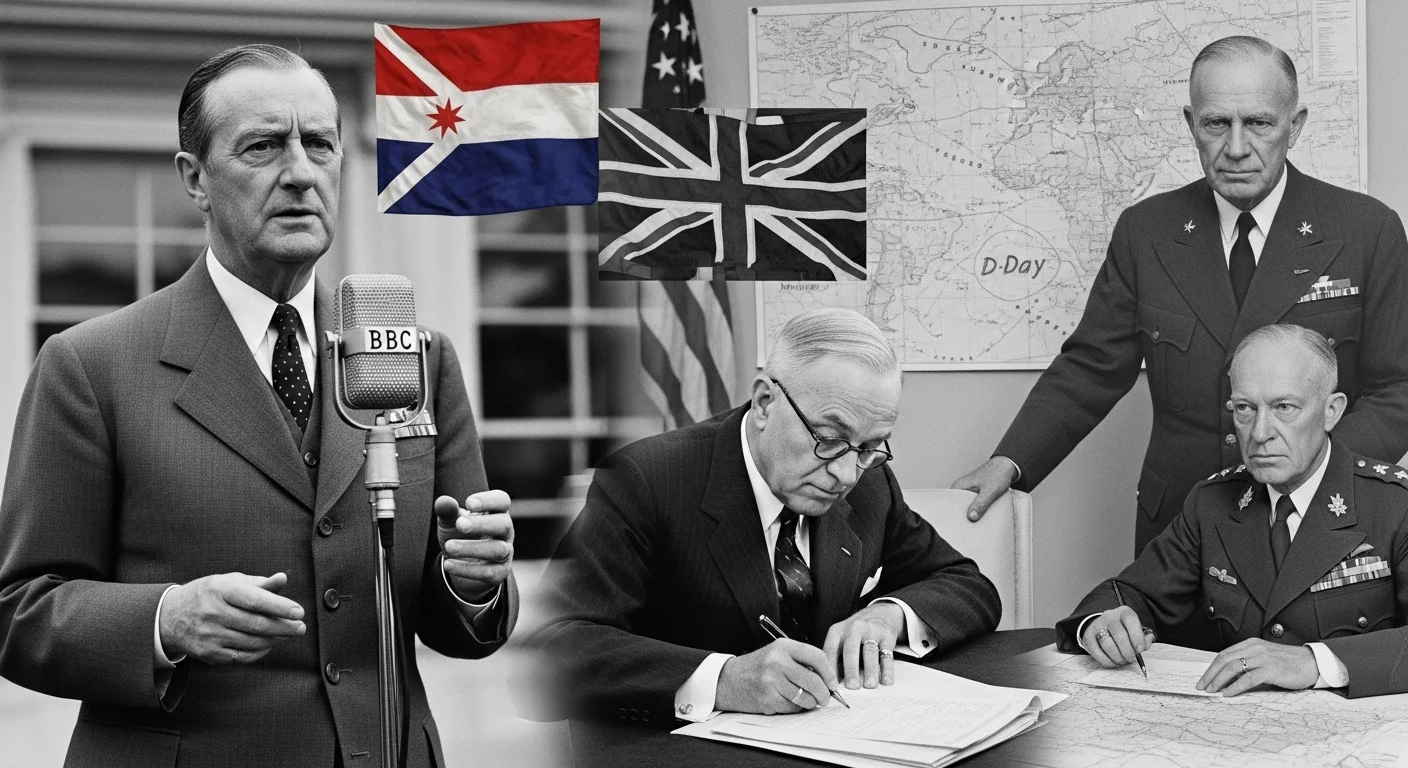
- Riddle: I was a French general who led the Free French from exile in London, rallying resistance against Nazi occupation. Who am I?
Hint: My BBC broadcast in 1940 called for continued fight against Germany.
Answer: Charles de Gaulle
- Riddle: I was the U.S. president who succeeded Roosevelt in 1945 and authorized the atomic bombs on Japan. Who am I?
Hint: I made the decision to end the war with nuclear weapons.
Answer: Harry S. Truman
- Riddle: I was the Supreme Allied Commander in Europe, overseeing D-Day, and later became U.S. president. Who am I?
Hint: My nickname was “Ike.”
Answer: Dwight D. Eisenhower
- Riddle: I was a Soviet general who led victories at Moscow, Stalingrad, and Berlin, shaping the Eastern Front. Who am I?
Hint: I’m considered one of WWII’s greatest commanders.
Answer: Georgy Zhukov
- Riddle: I was a British field marshal who led the Eighth Army to victory at El Alamein and later in Normandy. Who am I?
Hint: I wore two berets and was known for cautious tactics.
Answer: Bernard Montgomery
- Riddle: I was the U.S. general who promised “I shall return” to the Philippines and accepted Japan’s surrender. Who am I?
Hint: I led the Pacific campaign and wore a corncob pipe.
Answer: Douglas MacArthur
- Riddle: I was the British prime minister who declared war on Germany in 1939, known for appeasement. Who am I?
Hint: I resigned in 1940 after the fall of France.
Answer: Neville Chamberlain
- Riddle: I was the Chinese Nationalist leader who fought Japan, allied with the U.S. during the war. Who am I?
Hint: My wife spoke to the U.S. Congress to gain support.
Answer: Chiang Kai-shek
Axis Leaders
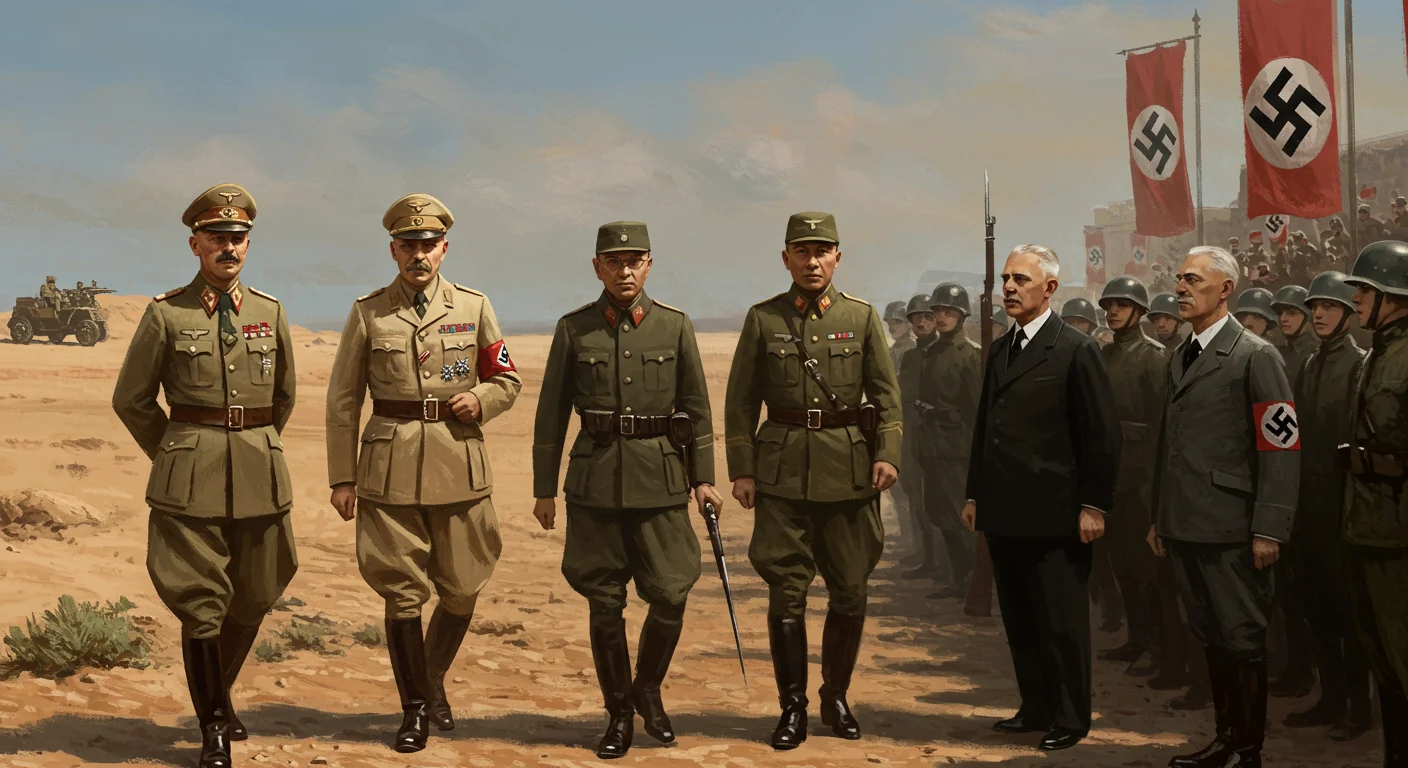
- Riddle: I was the German field marshal called the “Desert Fox” for my North African campaigns. Who am I?
Hint: I was later implicated in a plot against Hitler.
Answer: Erwin Rommel
- Riddle: I was Japan’s admiral who planned Pearl Harbor but was killed in 1943 by U.S. forces. Who am I?
Hint: I feared awakening a “sleeping giant.”
Answer: Isoroku Yamamoto
- Riddle: I was the Japanese prime minister who led during most of the war and was executed for war crimes. Who am I?
Hint: I was a general who pushed militarist policies.
Answer: Hideki Tojo
- Riddle: I was the Nazi propaganda minister who controlled Germany’s media and rallied for total war. Who am I?
Hint: My diaries revealed much about the Third Reich.
Answer: Joseph Goebbels
- Riddle: I was the head of the SS, notorious for my role in the Holocaust, but failed as an army commander. Who am I?
Hint: I spent time at a spa during key battles.
Answer: Heinrich Himmler
- Riddle: I was the Spanish dictator who stayed neutral but aided Axis powers with resources. Who am I?
Hint: I ruled Spain after a civil war.
Answer: Francisco Franco
- Riddle: I was the Vichy French leader, a WWI hero who collaborated with Germany after 1940. Who am I?
Hint: My government was based in a spa town.
Answer: Philippe Pétain
- Riddle: I was Hungary’s leader who allied with Germany but tried to exit the war, leading to my arrest. Who am I?
Hint: I was a regent for a kingdom without a king.
Answer: Miklós Horthy
Battles and Events
Battles are some of the events that made world war 2 the most significant. These are riddles which bring out their significance. To see other war themed challenges, see our war riddles.
Major Battles
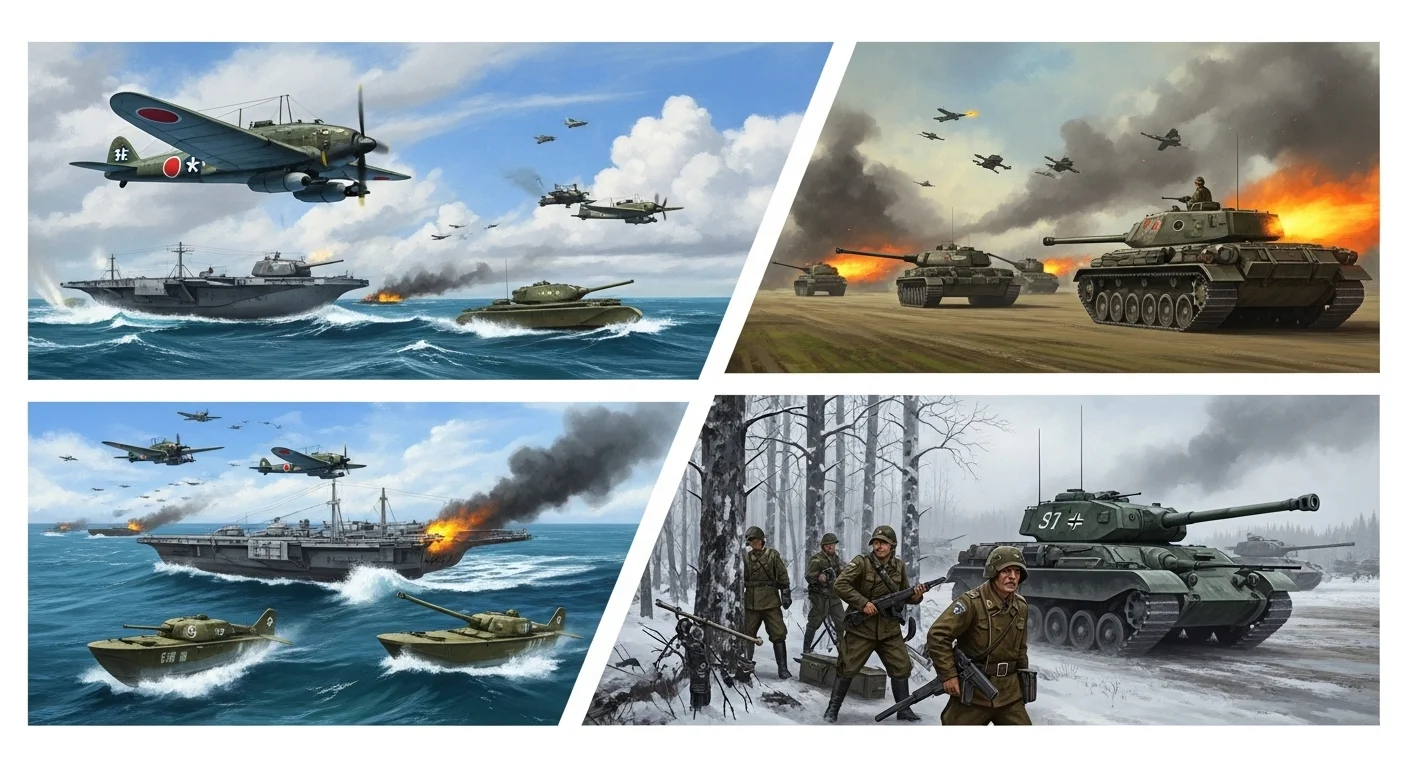
- Riddle: I was the 1940 evacuation of over 338,000 Allied troops from a French port using civilian boats. What am I?
Hint: I’m called a “miracle” of WWII.
Answer: Dunkirk Evacuation
- Riddle: I was the 1940 air battle where the RAF defended Britain from German bombers. What am I?
Hint: Churchill praised “the few” who fought me.
Answer: Battle of Britain
- Riddle: I was a 1942 Pacific battle where the U.S. sank four Japanese carriers, shifting the war’s tide. What am I?
Hint: I was fought near a small atoll.
Answer: Battle of Midway
- Riddle: I was the 1942–1943 North African battle where the British stopped Germany’s advance. What am I?
Hint: Montgomery’s victory here was a turning point.
Answer: Second Battle of El Alamein
- Riddle: I was the largest tank battle in 1943 on the Eastern Front, halting Germany’s offensive. What am I?
Hint: It involved thousands of tanks near Prokhorovka.
Answer: Battle of Kursk
- Riddle: I was the 1944 German offensive in the Ardennes, creating a bulge in Allied lines. What am I?
Hint: It was Hitler’s last major Western push.
Answer: Battle of the Bulge
- Riddle: I was the 1944 naval battle in the Philippines, the largest in history, crushing Japan’s navy. What am I?
Hint: It included the Battle of Surigao Strait.
Answer: Battle of Leyte Gulf
- Riddle: I was a 1943 Pacific battle where U.S. Marines faced fierce resistance on a small atoll. What am I?
Hint: My lessons improved amphibious landings.
Answer: Battle of Tarawa
Key Events
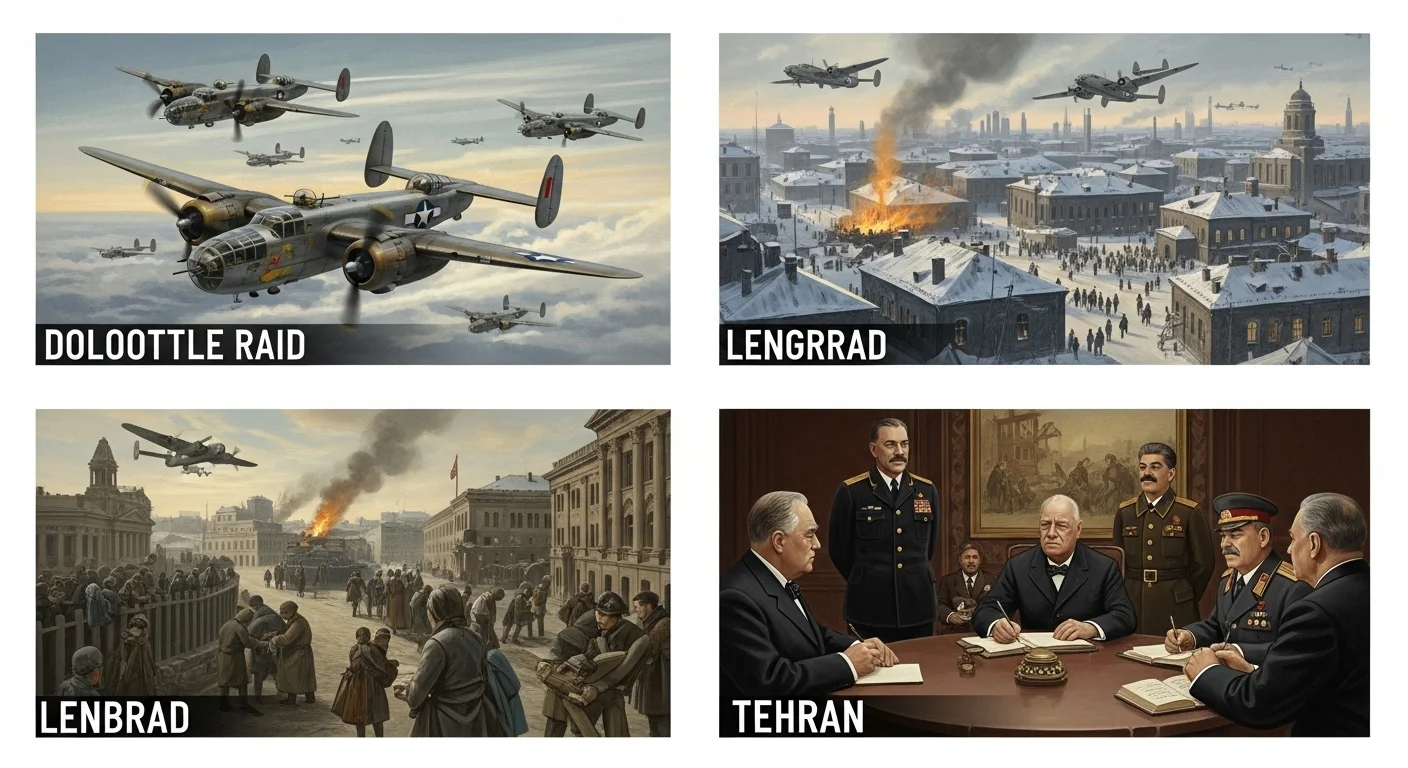
- Riddle: I was the 1941–1944 siege of a Soviet city, killing over a million civilians. What am I?
Hint: It lasted nearly 900 days.
Answer: Siege of Leningrad
- Riddle: I was the 1942 U.S. air raid on Tokyo, boosting Allied morale early in the war. What am I?
Hint: It was led by James Doolittle.
Answer: Doolittle Raid
- Riddle: I was the 1943 German operation to rescue Mussolini from captivity on a mountain. What am I?
Hint: Otto Skorzeny led my daring glider assault.
Answer: Operation Oak
- Riddle: I was the 1941 German invasion of the Soviet Union, breaking a non-aggression pact. What am I?
Hint: My name references a medieval emperor.
Answer: Operation Barbarossa
- Riddle: I was the 1944 Allied operation to seize Dutch bridges, but failed at Arnhem. What am I?
Hint: It inspired the film “A Bridge Too Far.”
Answer: Operation Market Garden
- Riddle: I was the 1943 conference where Roosevelt, Churchill, and Stalin planned the invasion of Europe. What am I?
Hint: It was held in Iran’s capital.
Answer: Tehran Conference
- Riddle: I was the 1945 firebombing of a Japanese city, killing more than atomic bombs in one night. What am I?
Hint: It targeted Tokyo with incendiaries.
Answer: Operation Meetinghouse
- Riddle: I was the 1942 internment of Japanese-Americans in the U.S. due to war fears. What am I?
Hint: It’s now seen as a civil rights violation.
Answer: Japanese-American Internment
Technology and Weapons
World War 2 came out with new revolutionized technologies that overturned war fighting. Those innovations are explored using these riddles. Delve into the technology of war in our weapons riddles.
Aircraft
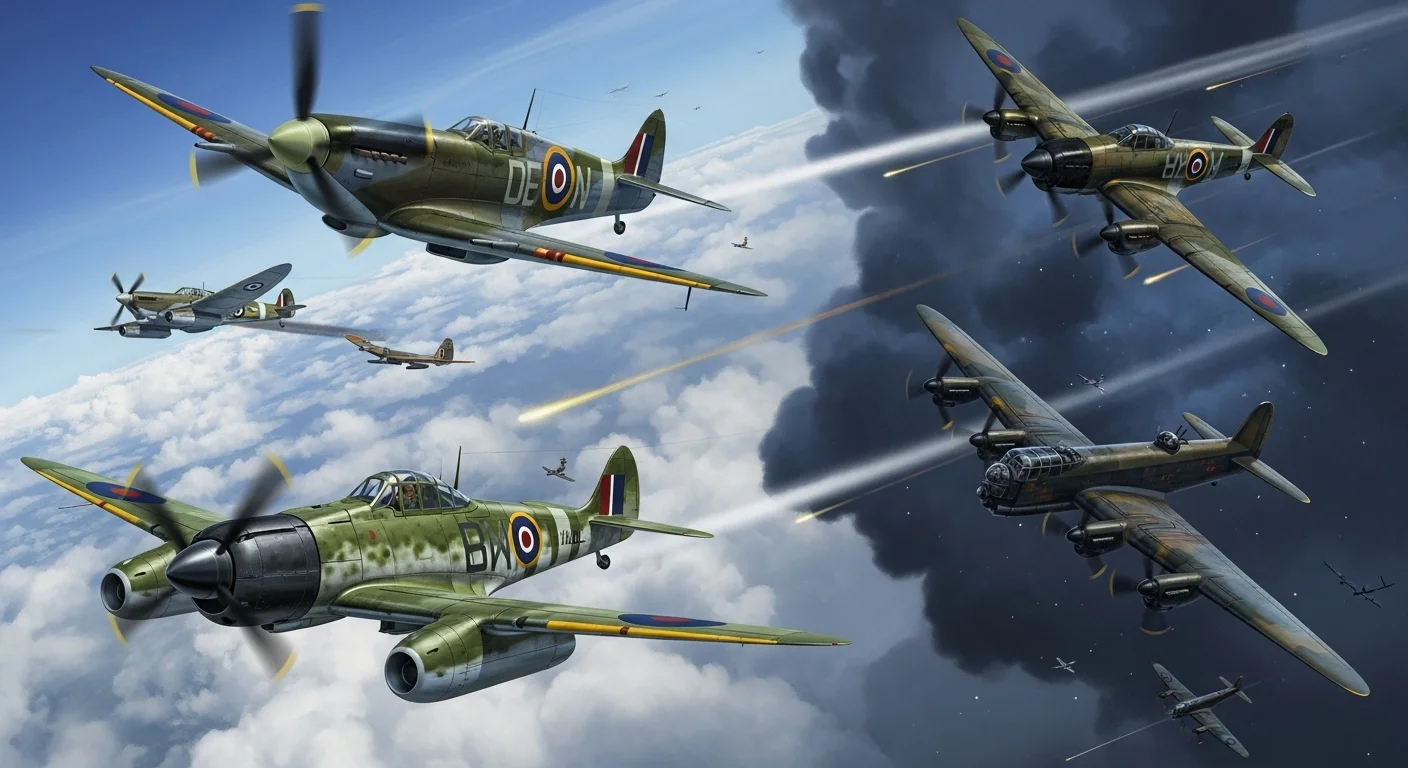
- Riddle: I was Britain’s iconic fighter with elliptical wings, key in the Battle of Britain. What am I?
Hint: My rival was the Messerschmitt Bf 109.
Answer: Supermarine Spitfire
- Riddle: I was the U.S. heavy bomber that dropped atomic bombs on Japan. What am I?
Hint: My name includes a “super” prefix.
Answer: B-29 Superfortress
- Riddle: I was Germany’s first jet fighter, operational in 1944 but plagued by engine issues. What am I?
Hint: I was faster than Allied fighters but unreliable.
Answer: Messerschmitt Me 262 (Photographic evidence of the Messerschmitt Me 262 can be found in the Imperial War Museums collection.)
- Riddle: I was a Japanese fighter plane, agile but lightly armored, used throughout the war. What am I?
Hint: My nickname was a number, “Zero.”
Answer: Mitsubishi A6M Zero
- Riddle: I was a Soviet fighter plane, rugged and effective on the Eastern Front. What am I?
Hint: My designer’s name begins with “Yak.”
Answer: Yak-3
- Riddle: I was a British bomber that carried out night raids over Germany. What am I?
Hint: My four engines and heavy payload made me a workhorse.
Answer: Avro Lancaster
Weapons
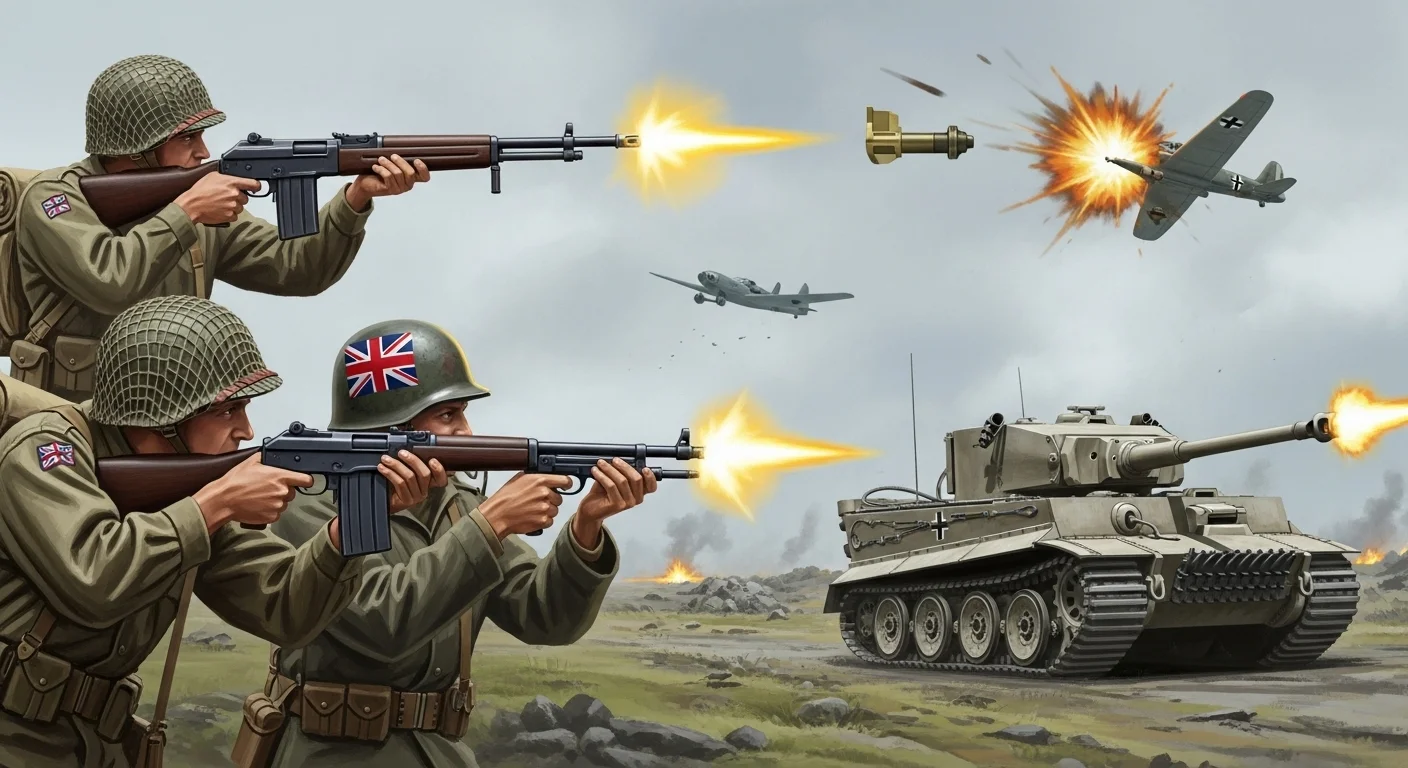
- Riddle: I was a U.S. rocket launcher that destroyed tanks, named after a musical instrument. What am I?
Hint: My portability changed anti-tank warfare.
Answer: Bazooka
- Riddle: I was the U.S. semi-automatic rifle, standard for infantry, praised for reliability. What am I?
Hint: General Patton called me “the greatest battle implement.”
Answer: M1 Garand
- Riddle: I was a British cheap submachine gun, mass-produced for resistance fighters. What am I?
Hint: My name combines designers’ initials and “Enfield.”
Answer: Sten Gun
- Riddle: I was a fuze that made anti-aircraft shells explode near targets, a secret Allied weapon. What am I?
Hint: My use increased Allied air defense success.
Answer: Proximity Fuze
- Riddle: I was a German tank, heavily armored, feared on the battlefield. What am I?
Hint: My name means “big cat.”
Answer: Tiger Tank
- Riddle: I was a Soviet tank, mass-produced and key to victories like Kursk. What am I?
Hint: My sloped armor inspired modern tank design.
Answer: T-34
Strategies and Tactics
World War 2 was characterized by military finding. These trivia are riddles about them.
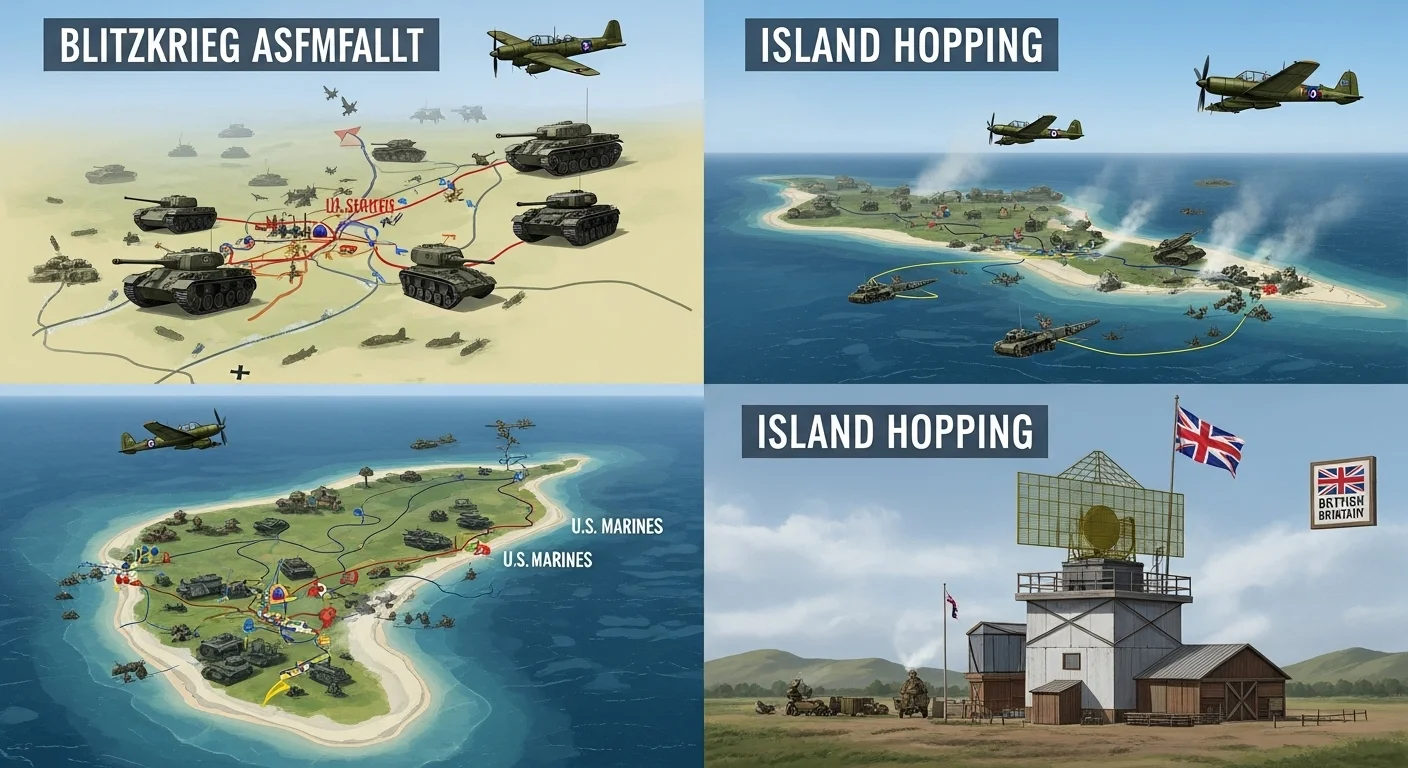
- Riddle: I was Germany’s rapid attack strategy using tanks and planes to overwhelm foes. What am I?
Hint: My name means “lightning war.”
Answer: Blitzkrieg
- Riddle: I was the Allied Pacific strategy to capture key islands, bypassing Japanese strongholds. What am I?
Hint: It brought the Allies closer to Japan.
Answer: Island Hopping
- Riddle: I was Britain’s counterintelligence operation turning German spies into double agents. What am I?
Hint: I deceived Germany about D-Day.
Answer: Double Cross System
- Riddle: I was the Soviet strategy of destroying resources to deny them to invaders. What am I?
Hint: It slowed Germany’s advance in 1941.
Answer: Scorched Earth
- Riddle: I was Japan’s tactic of pilots crashing planes into ships, used late in the war. What am I?
Hint: My name means “divine wind.”
Answer: Kamikaze Attacks
- Riddle: I was the Allied system of grouping merchant ships with warship escorts against U-boats. What am I?
Hint: I protected vital Atlantic supply lines.
Answer: Convoy System
- Riddle: I was Britain’s integrated air defense using radar and fighters against the Luftwaffe. What am I?
Hint: I was vital in the Battle of Britain.
Answer: Dowding System
- Riddle: I was the German strategy of sinking merchant ships without warning using submarines. What am I?
Hint: It provoked the U.S. to join the war.
Answer: Unrestricted Submarine Warfare
Places and Locations
There were numerous important battlefields in the World War 2. All these riddles indicate their importance.
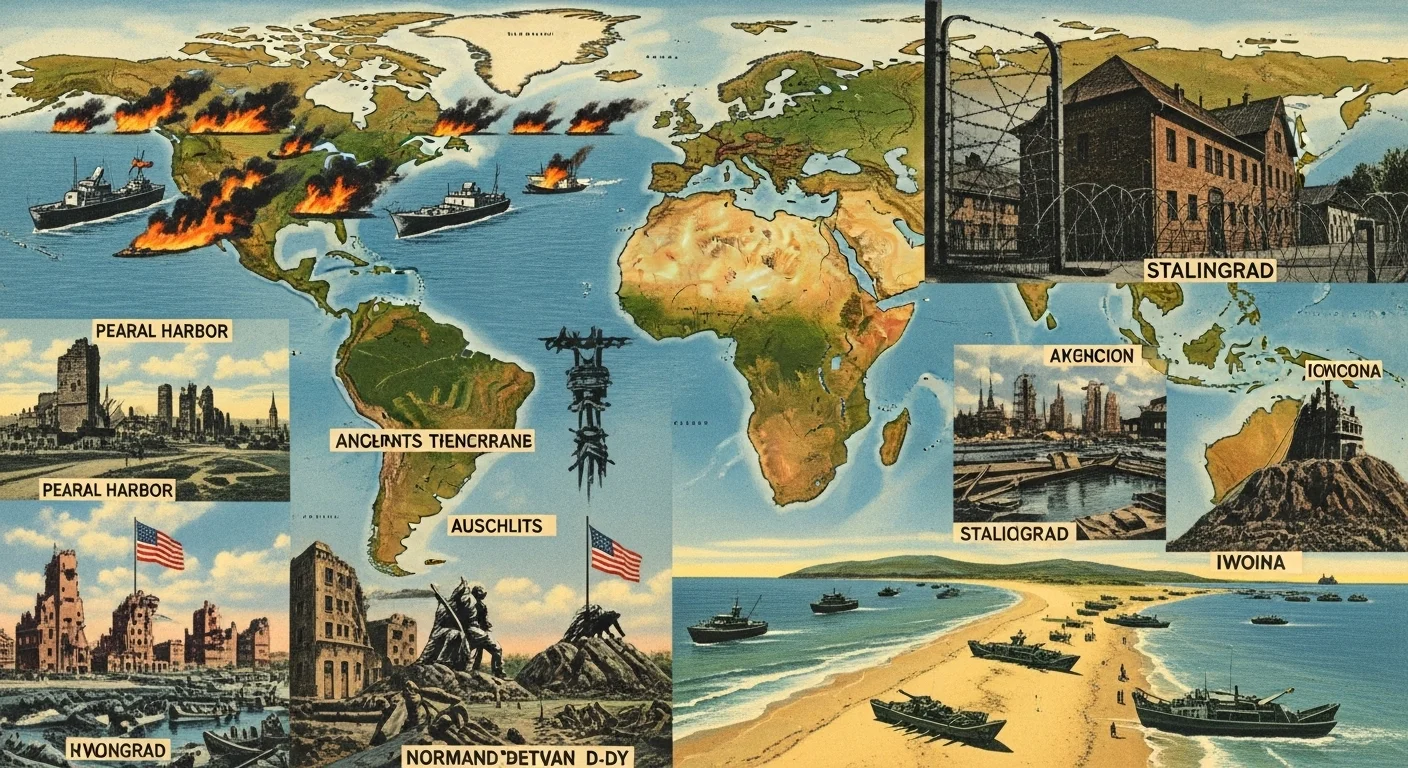
- Riddle: I was a Hawaiian naval base attacked by Japan in 1941, sparking U.S. entry into the war. What am I?
Hint: The date was December 7.
Answer: Pearl Harbor
- Riddle: I was a Polish camp where over a million died, a symbol of the Holocaust. What am I?
Hint: My name is synonymous with Nazi atrocities.
Answer: Auschwitz
- Riddle: I was the ship in Tokyo Bay where Japan surrendered in 1945. What am I?
Hint: I’m named after a U.S. state.
Answer: USS Missouri
- Riddle: I was a French region where Allies landed on June 6, 1944, to liberate Europe. What am I?
Hint: My beaches included Omaha and Juno.
Answer: Normandy
- Riddle: I was a Soviet city, site of a 1942–1943 battle that turned the Eastern Front. What am I?
Hint: My name was later changed to Volgograd.
Answer: Stalingrad
- Riddle: I was a British territory in Asia, captured by Japan in 1942, a major Allied defeat. What am I?
Hint: My fall was called Britain’s worst military disaster.
Answer: Singapore
- Riddle: I was a Dutch city where a 1944 bridge battle failed, halting Allied advance. What am I?
Hint: It was part of Operation Market Garden.
Answer: Arnhem
- Riddle: I was a Pacific island where a 1945 battle saw a famous flag-raising photo. What am I?
Hint: My name starts with “Iwo.”
Answer: Iwo Jima
Dates and Timelines
The history of World War 2 is pinned on key dates. The riddles test your knowledge of time lines.
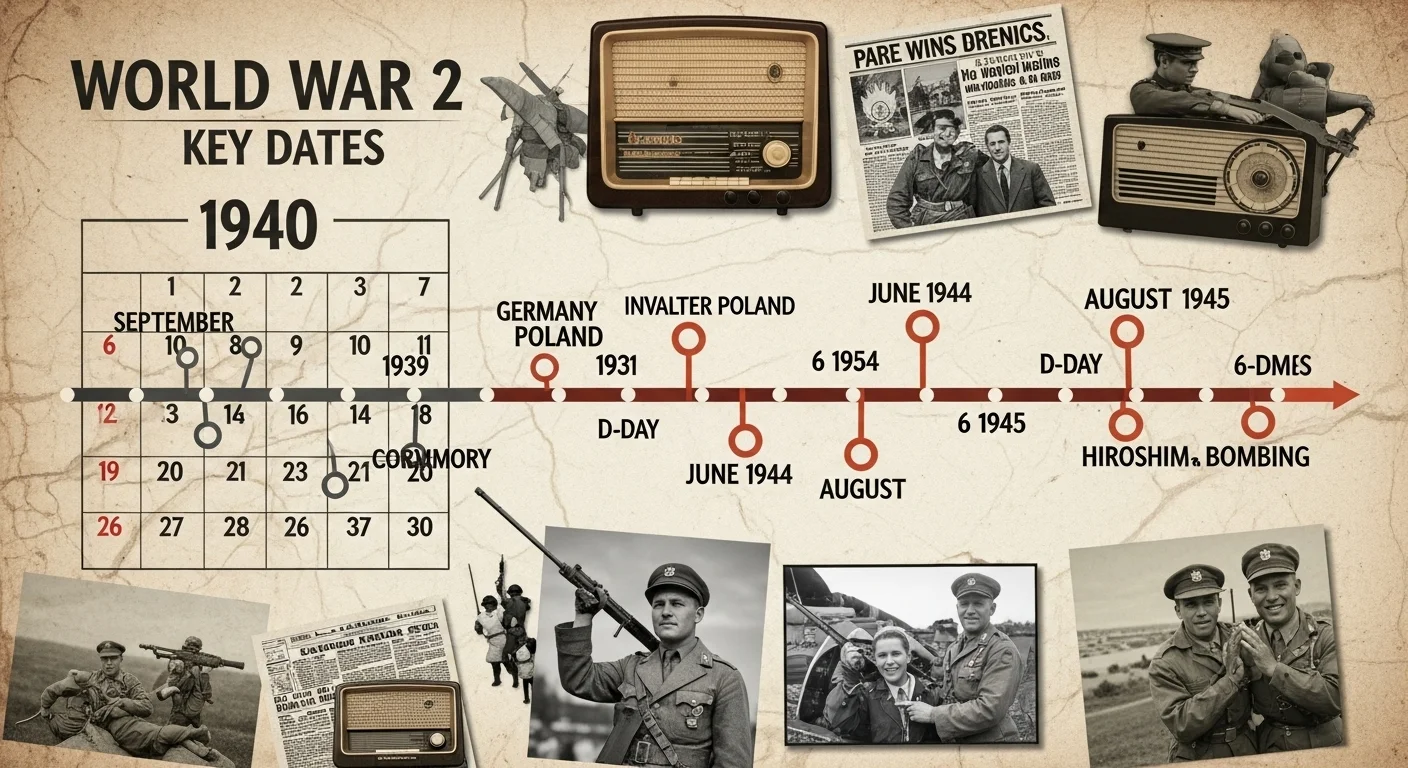
- Riddle: I was the year Germany invaded Poland, starting WWII in Europe. What am I?
Hint: It was two years before Pearl Harbor.
Answer: 1939
- Riddle: I was the year of the D-Day invasion, a turning point in Western Europe. What am I?
Hint: It was one year before Germany’s surrender.
Answer: 1944
- Riddle: I was the year Japan surrendered after atomic bombings. What am I?
Hint: It marked the end of WWII.
Answer: 1945
- Riddle: I was the year of the Pearl Harbor attack, bringing the U.S. into the war. What am I?
Hint: It was two years after Germany invaded Poland.
Answer: 1941
- Riddle: I was the year of the Battle of Midway, a Pacific turning point. What am I?
Hint: It was one year after the U.S. entered the war.
Answer: 1942
- Riddle: I was the year Germany surrendered, ending the war in Europe. What am I?
Hint: It was months before Japan’s surrender.
Answer: 1945
- Riddle: I was the date when Germany invaded the Soviet Union, launching a massive campaign. What am I?
Hint: It was June 22, 1941.
Answer: June 22, 1941
- Riddle: I was the date of the atomic bombing of Hiroshima. What am I?
Hint: It was August 6, 1945.
Answer: August 6, 1945
Miscellaneous
The riddles touch upon not very well-known but interesting details of the World War 2.
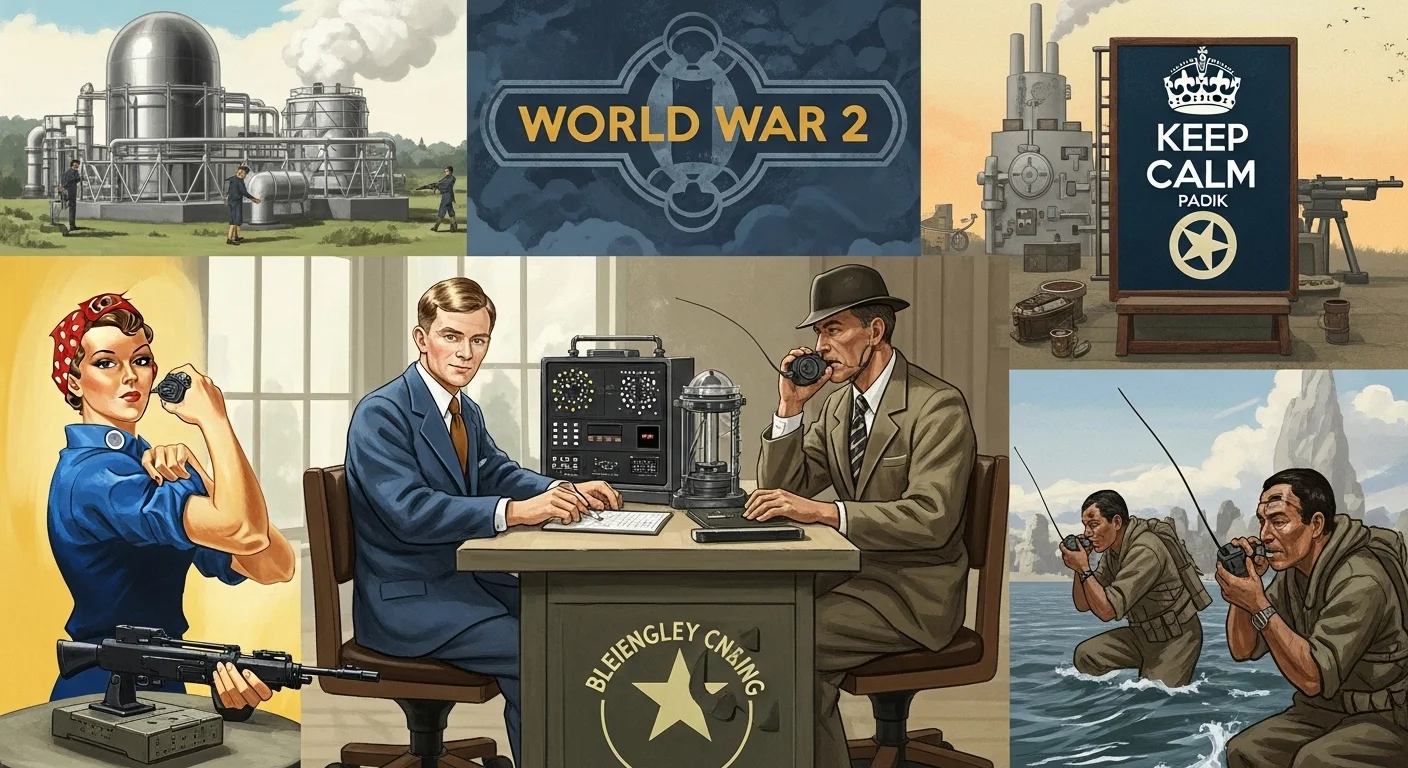
- Riddle: I was the U.S. icon of women workers in WWII factories, symbolizing empowerment. Who am I?
Hint: My poster said, “We Can Do It!”
Answer: Rosie the Riveter
- Riddle: I was the British mathematician who cracked Enigma codes, aiding Allied victories. Who am I?
Hint: I worked at Bletchley Park and inspired a film.
Answer: Alan Turing
- Riddle: I was the U.S. program that built the atomic bomb, employing thousands in secret. What am I?
Hint: My sites included Los Alamos and Oak Ridge.
Answer: Manhattan Project
- Riddle: I was the Nazi symbol banned in many countries after the war due to its associations. What am I?
Hint: It’s a hooked cross design.
Answer: Swastika
- Riddle: I was the U.S. poster character urging civilians to support the war effort. Who am I?
Hint: I’m depicted with a beard and top hat.
Answer: Uncle Sam
- Riddle: I was the British operation using bouncing bombs to breach German dams in 1943. What am I?
Hint: It was called the Dambusters Raid.
Answer: Operation Chastise
- Riddle: I was the antibiotic mass-produced during WWII, saving countless lives. What am I?
Hint: I was discovered by Alexander Fleming.
Answer: Penicillin
- Riddle: I was the U.S. vehicle iconic for its versatility in WWII, used by all Allied forces. What am I?
Hint: My name became a brand after the war.
Answer: Jeep
Additional World War 2 Riddles to Meet 125+ Collection
There are numerous sub categories to be given in this section to discuss World War 2 Riddles.
Military Units and Formations
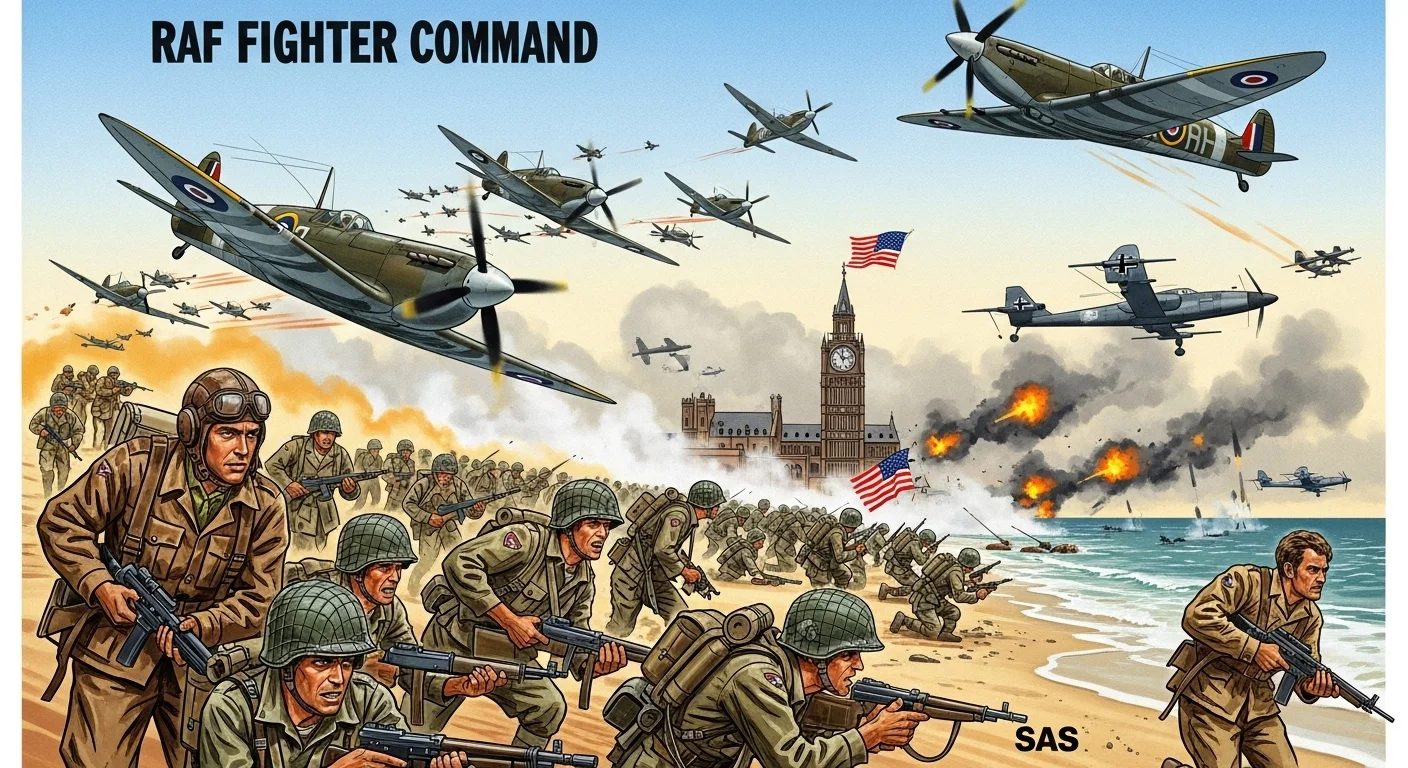
- Riddle: I was the British air force unit that defended the skies during the Battle of Britain. What am I?
Hint: My pilots were called “the few” by Churchill.
Answer: Royal Air Force (RAF) Fighter Command
- Riddle: I was the U.S. Army division that landed on Omaha Beach during D-Day. What am I?
Hint: My nickname is “Big Red One.”
Answer: 1st Infantry Division
- Riddle: I was the German air force that bombed Britain but failed to gain air superiority. What am I?
Hint: My name means “air weapon” in German.
Answer: Luftwaffe
- Riddle: I was the Soviet army group that encircled German forces at Stalingrad. What am I?
Hint: My name includes “Front” and a river.
Answer: Don Front
- Riddle: I was the U.S. Marine division that fought at Iwo Jima, raising the flag on Mount Suribachi. What am I?
Hint: I’m the 5th Marine Division.
Answer: 5th Marine Division
- Riddle: I was the British commando unit trained for special operations behind enemy lines. What am I?
Hint: My name reflects elite, small-scale units.
Answer: Special Air Service (SAS)
Secret Operations and Espionage
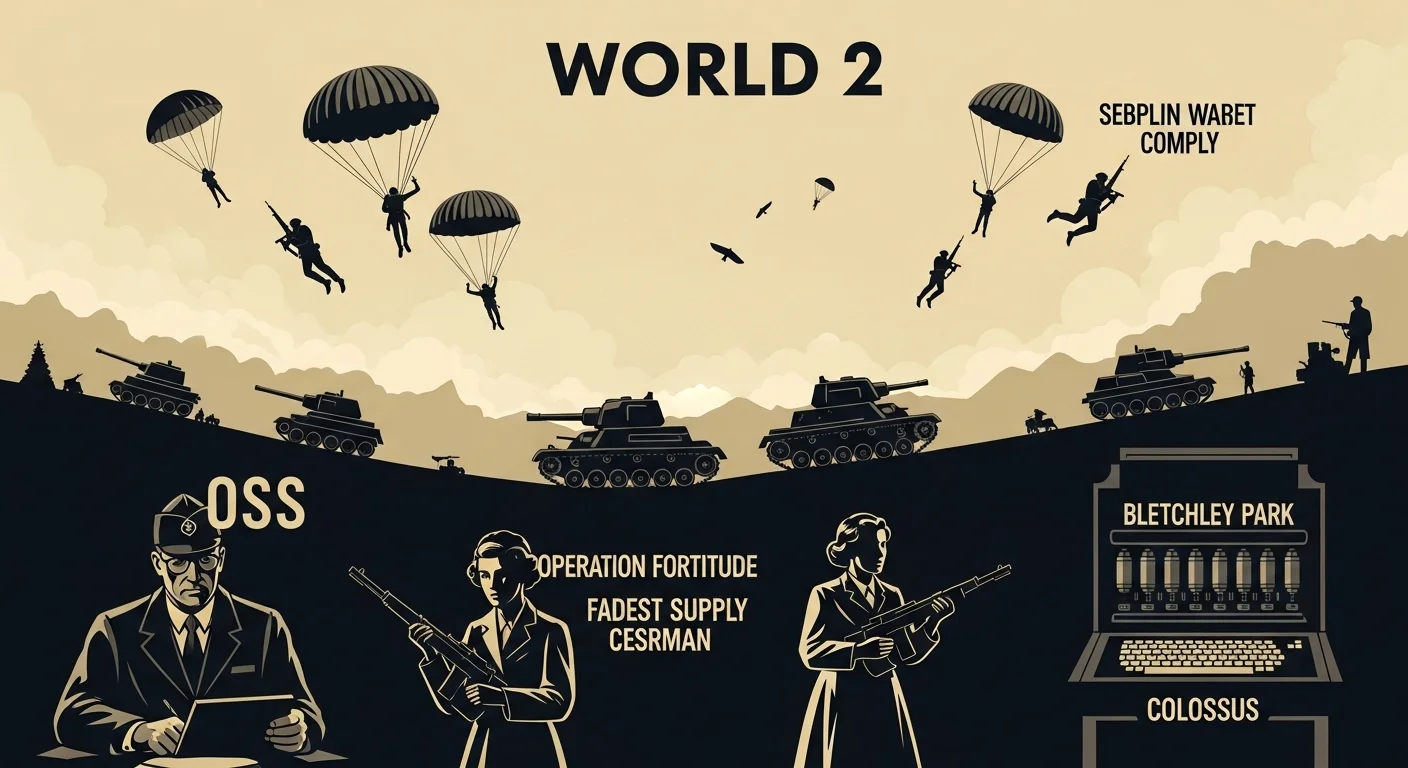
- Riddle: I was the U.S. agency that conducted espionage and sabotage against Axis powers. What am I?
Hint: I was the precursor to the CIA.
Answer: Office of Strategic Services (OSS)
- Riddle: I was the British operation to deceive Germany about D-Day’s landing site. What am I?
Hint: I used fake armies and double agents.
Answer: Operation Fortitude
- Riddle: I was the German spy ring in the U.S., but my members were caught and executed. What am I?
Hint: My name references a 1942 sabotage attempt.
Answer: Operation Pastorius
- Riddle: I was the Allied mission to capture German nuclear scientists and research. What am I?
Hint: My name starts with “Alsos.”
Answer: Alsos Mission
- Riddle: I was the British computer used to break German codes at Bletchley Park. What am I?
Hint: I was the first programmable digital computer.
Answer: Colossus
- Riddle: I was the female spy who worked for the French Resistance, captured but survived. Who am I?
Hint: My codename was “White Mouse.”
Answer: Nancy Wake
Home Front and Civilian Life
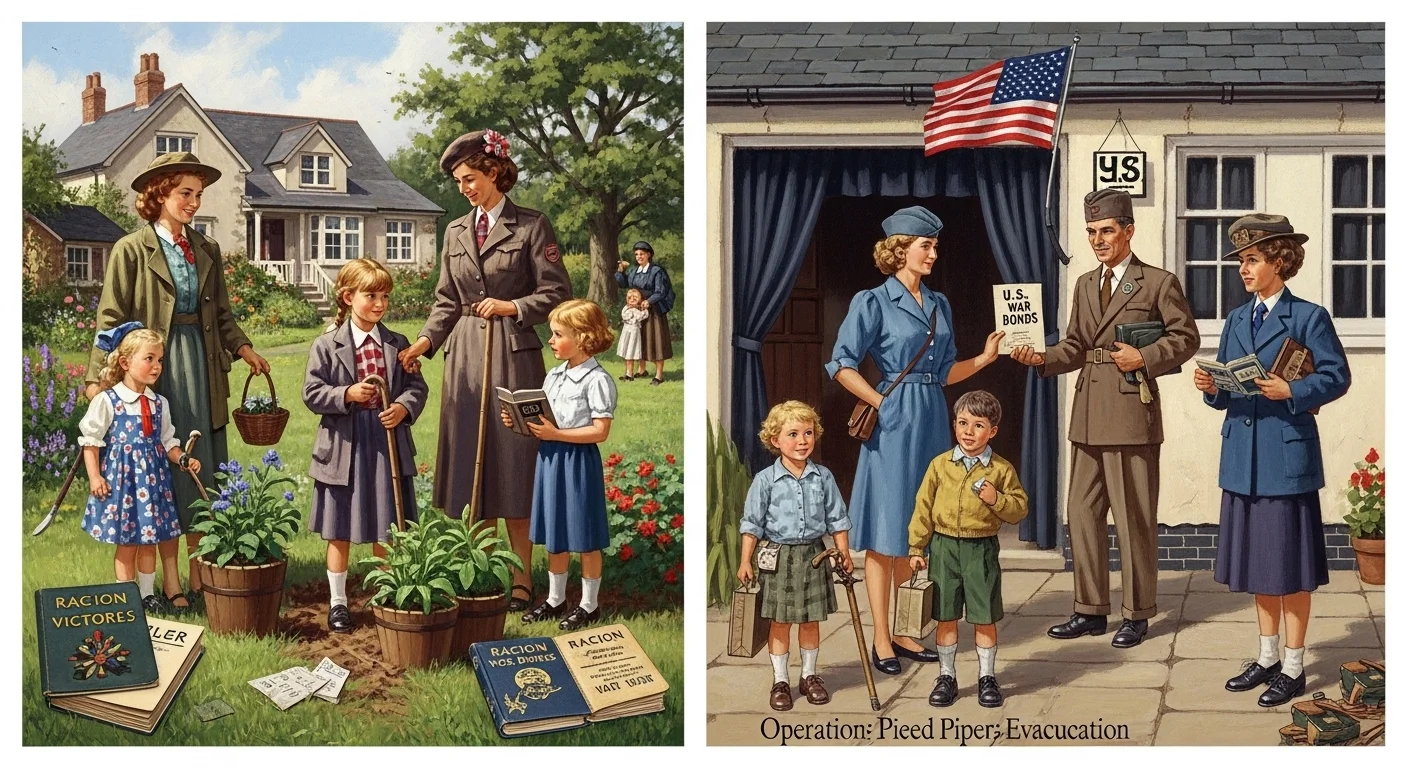
- Riddle: I was the British campaign urging civilians to grow food in gardens during WWII. What am I?
Hint: My slogan was about digging for victory.
Answer: Dig for Victory
- Riddle: I was the U.S. system of limiting food and goods to support the war effort. What am I?
Hint: Civilians used books with stamps for purchases.
Answer: Rationing
- Riddle: I was the British blackout policy to hide cities from German bombers. What am I?
Hint: Lights were dimmed or covered at night.
Answer: Blackout
- Riddle: I was the U.S. program where civilians bought bonds to fund the war. What am I?
Hint: My name suggests winning through investment.
Answer: War Bonds
- Riddle: I was the British evacuation of children from cities to the countryside. What am I?
Hint: My name is Operation Pied Piper.
Answer: Operation Pied Piper
- Riddle: I was the Japanese-American group who faced internment but served bravely in Europe. What am I?
Hint: My unit was the 442nd Regimental Combat Team.
Answer: Nisei Soldiers
Propaganda and Media
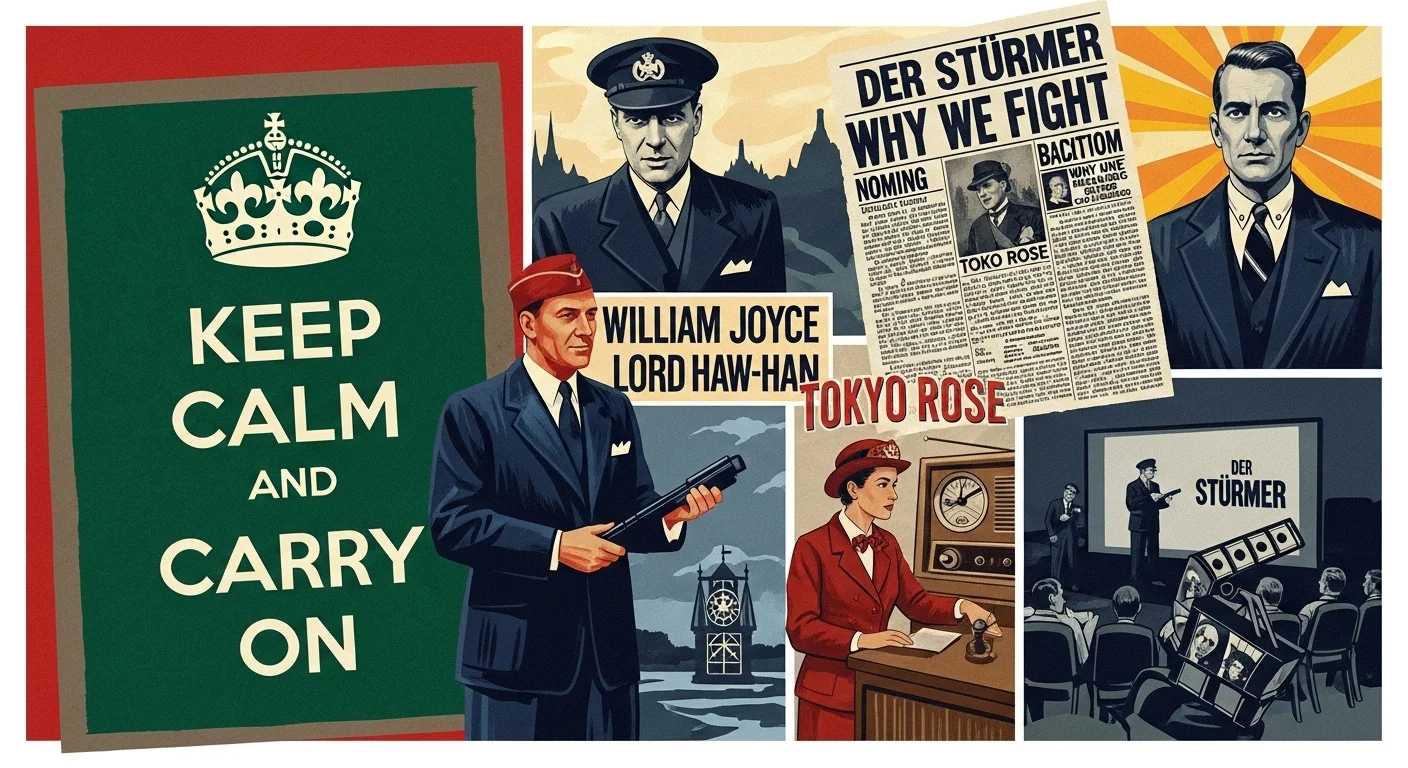
- Riddle: I was the British broadcaster who mocked Hitler on radio, gaining a cult following. Who am I?
Hint: My nickname was “Lord Haw-Haw.”
Answer: William Joyce
- Riddle: I was the U.S. film series showing war’s realities to boost support. What am I?
Hint: Frank Capra directed me.
Answer: Why We Fight
- Riddle: I was the Nazi newspaper spreading anti-Semitic propaganda. What am I?
Hint: My name means “The Attacker.”
Answer: Der Stürmer
- Riddle: I was the Japanese radio broadcaster urging Allied troops to surrender. Who am I?
Hint: My nickname was a city’s name.
Answer: Tokyo Rose
- Riddle: I was the British poster urging calm during air raids. What am I?
Hint: My slogan was “Keep Calm and Carry On.”
Answer: Keep Calm and Carry On Poster
- Riddle: I was the U.S. cartoon character used in training films for soldiers. Who am I?
Hint: My name is Private Snafu.
Answer: Private Snafu
Post-War Consequences and Legacy
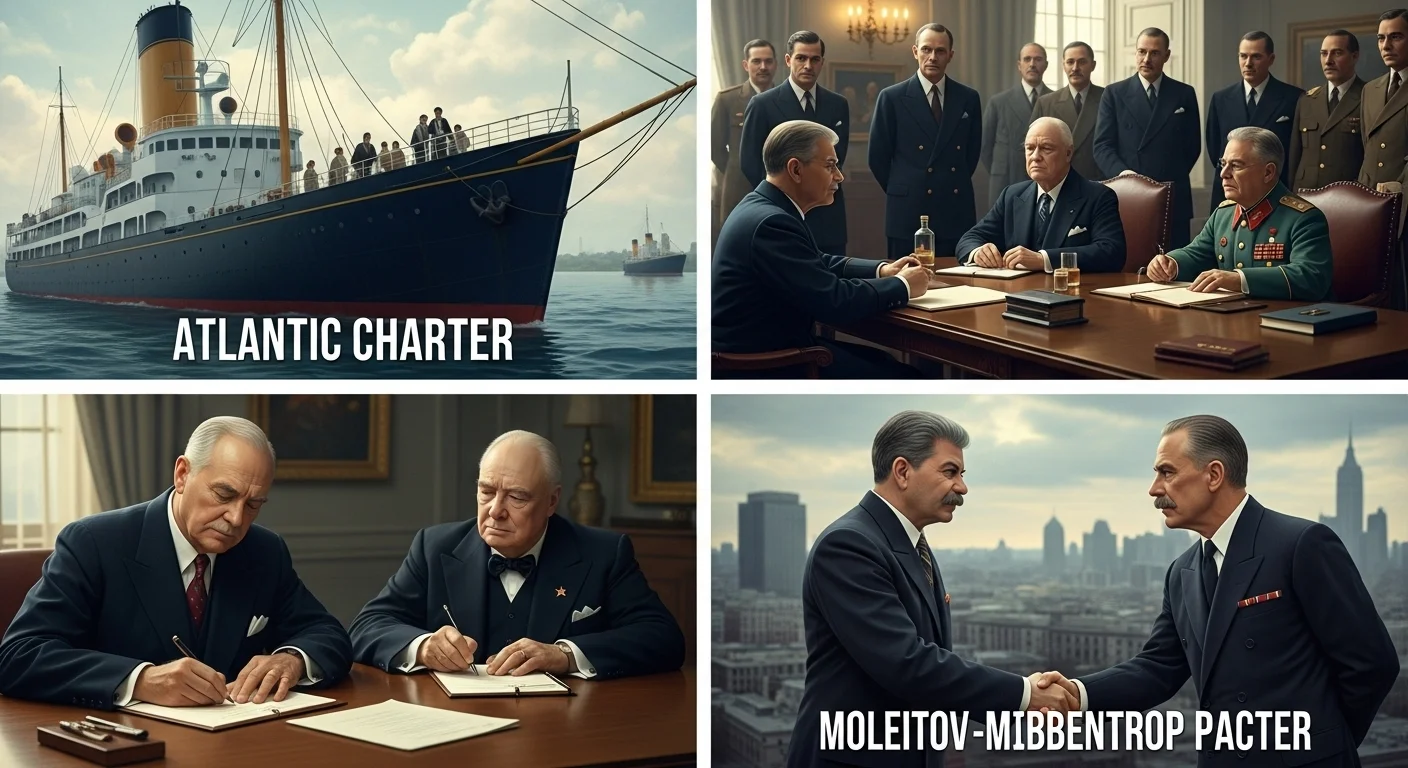
- Riddle: I was the 1945–1946 trials of Nazi leaders for war crimes. What am I?
Hint: I was held in a German city.
Answer: Nuremberg Trials
- Riddle: I was the U.S. plan to rebuild Europe after WWII, aiding recovery. What am I?
Hint: My name honors a U.S. secretary of state.
Answer: Marshall Plan
- Riddle: I was the 1945 organization formed to maintain global peace post-war. What am I?
Hint: My headquarters is in New York.
Answer: United Nations
- Riddle: I was the division of Germany into zones after WWII, lasting until 1990. What am I?
Hint: My name includes “Wall.”
Answer: Berlin Wall (or Division of Germany)
- Riddle: I was the 1945 agreement dividing Korea, leading to later conflict. What am I?
Hint: It was decided at a conference in Crimea.
Answer: Yalta Agreement
- Riddle: I was the post-war tribunal for Japanese war criminals. What am I?
Hint: I’m also called the Tokyo Trials.
Answer: International Military Tribunal for the Far East
Key Treaties and Agreements
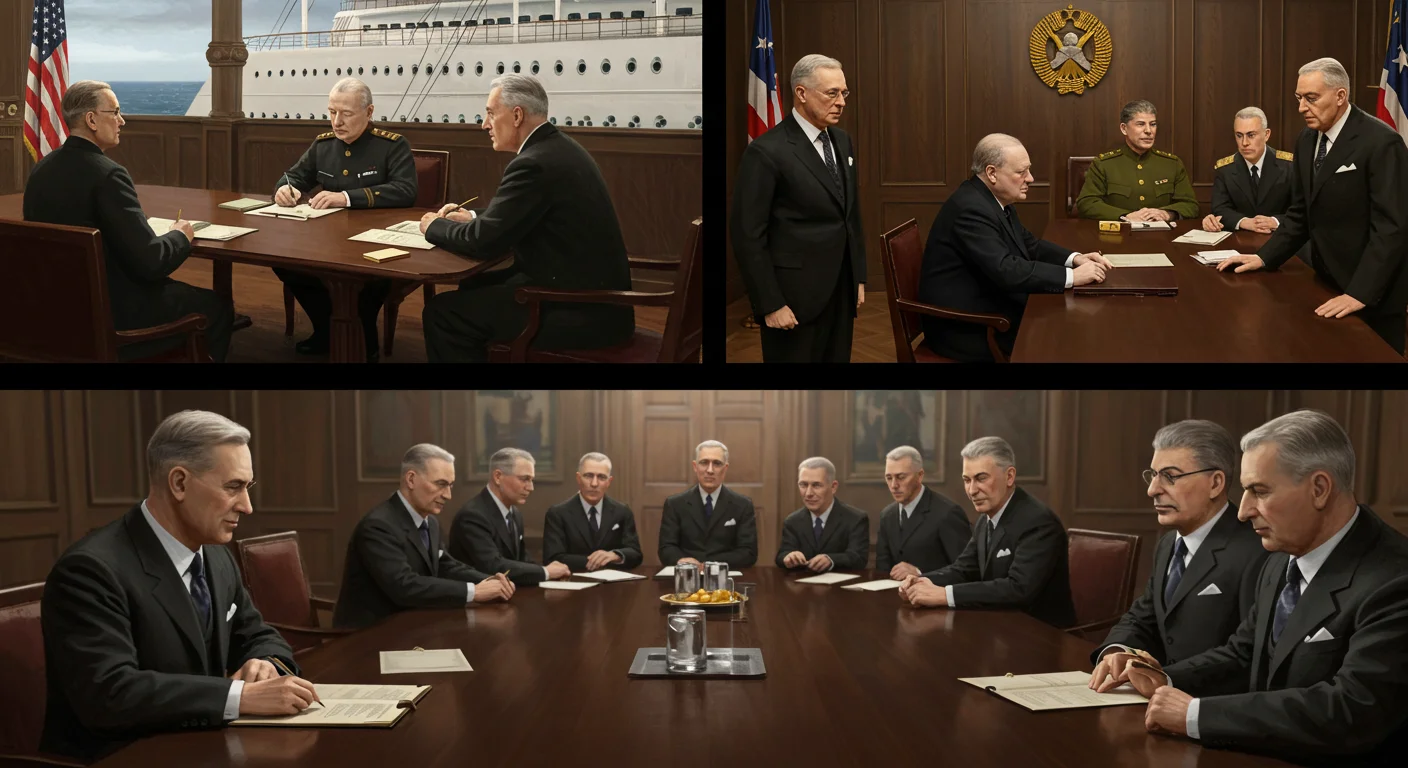
- Riddle: I was the 1939 pact between Germany and the USSR, dividing Eastern Europe. What am I?
Hint: My name includes two foreign ministers.
Answer: Molotov-Ribbentrop Pact
- Riddle: I was the 1941 agreement between the U.S. and UK outlining war aims. What am I?
Hint: I was signed on a ship.
Answer: Atlantic Charter
- Riddle: I was the 1943 agreement demanding Axis powers surrender completely. What am I?
Hint: It was decided in Morocco.
Answer: Casablanca Conference (Unconditional Surrender)
- Riddle: I was the 1945 agreement on post-war Europe, held in Crimea. What am I?
Hint: Stalin, Roosevelt, and Churchill attended.
Answer: Yalta Conference
- Riddle: I was the 1945 agreement on Germany’s occupation, held in Germany. What am I?
Hint: It followed Yalta and set up four zones.
Answer: Potsdam Conference
- Riddle: I was the 1942 agreement for Allied nations to fight until victory. What am I?
Hint: It formed the basis of the United Nations.
Answer: Declaration by United Nations
Naval and Air Forces
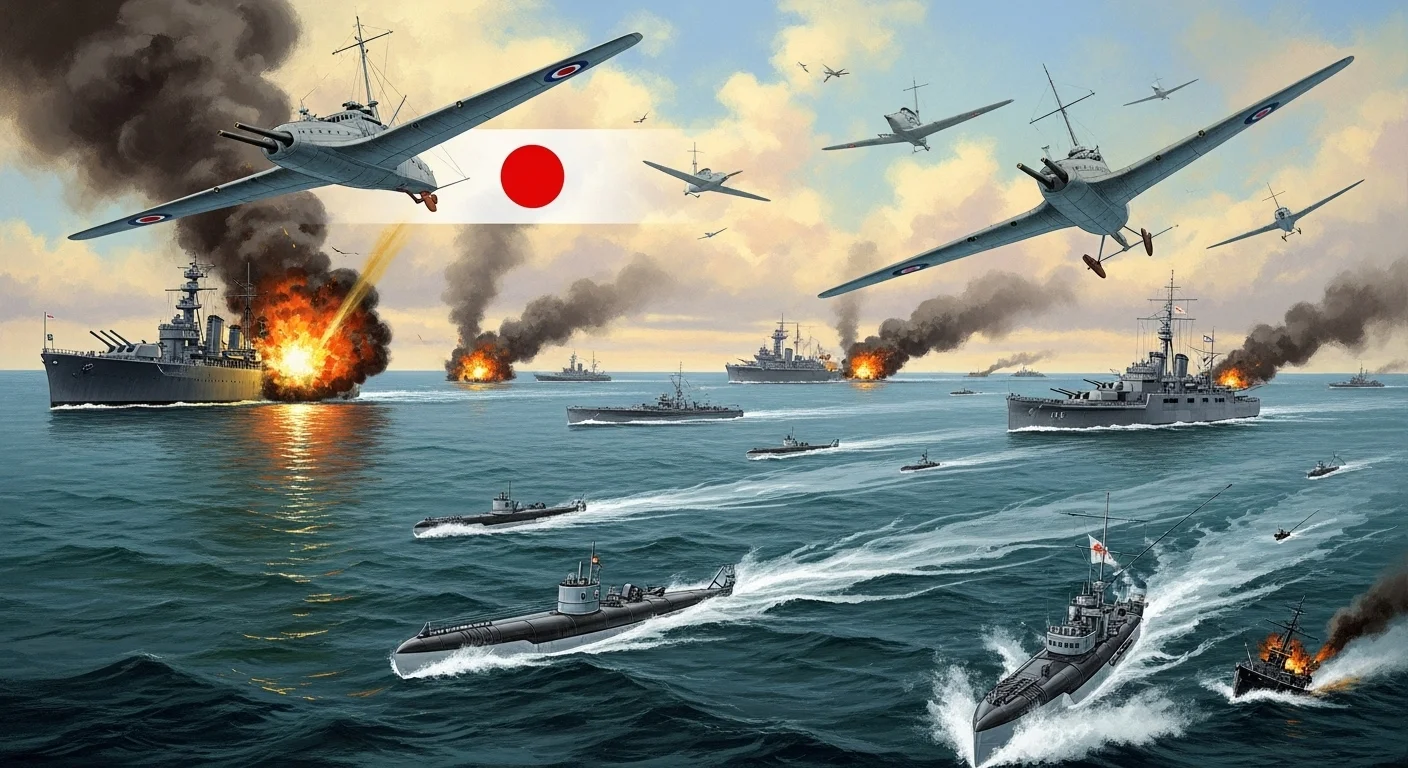
- Riddle: I was the Japanese navy that attacked Pearl Harbor, dominant early in the war. What am I?
Hint: My name means “Combined Fleet.”
Answer: Imperial Japanese Navy
- Riddle: I was the U.S. carrier sunk at Midway but helped win the battle. What am I?
Hint: My name is a stinging insect.
Answer: USS Hornet
- Riddle: I was the German battleship sunk after a chase in 1941. What am I?
Hint: My name honors a Prussian chancellor.
Answer: Bismarck
- Riddle: I was the British navy that hunted German U-boats in the Atlantic. What am I?
Hint: My name includes “Royal.”
Answer: Royal Navy
- Riddle: I was the U.S. air force unit that flew dangerous missions over the Himalayas. What am I?
Hint: My nickname was “Hump Pilots.”
Answer: Air Transport Command (China-Burma-India Theater)
- Riddle: I was the German submarine fleet that terrorized Allied shipping. What am I?
Hint: My name means “undersea boat.”
Answer: U-boat Fleet
Resistance Movements
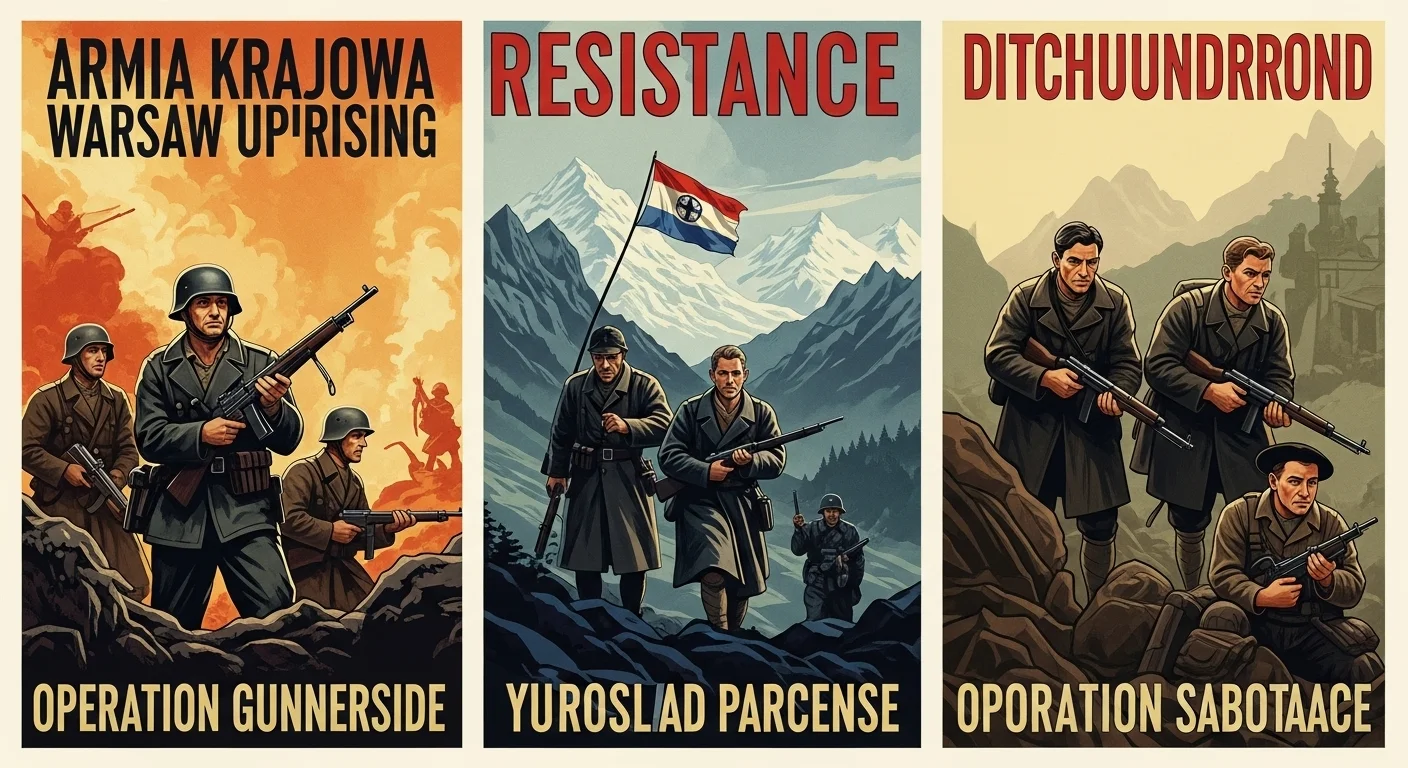
- Riddle: I was the Polish underground army that fought the Nazis, including in a 1944 uprising. What am I?
Hint: My name means “Home Army.”
Answer: Armia Krajowa
- Riddle: I was the Yugoslav partisan leader who resisted Axis occupation. Who am I?
Hint: I later led communist Yugoslavia.
Answer: Josip Broz Tito
- Riddle: I was the Norwegian resistance operation that sabotaged German heavy water production. What am I?
Hint: My name is Operation Gunnerside.
Answer: Operation Gunnerside
- Riddle: I was the Dutch resistance group that hid Jews and aided Allied pilots. What am I?
Hint: My name includes “Underground.”
Answer: Dutch Underground
- Riddle: I was the French resistance network led by a man who later became president. What am I?
Hint: My leader was Charles de Gaulle.
Answer: Free French Forces
- Riddle: I was the Belgian resistance group that disrupted German supply lines. What am I?
Hint: My name means “White Brigade.”
Answer: White Brigade
War Crimes and Trials
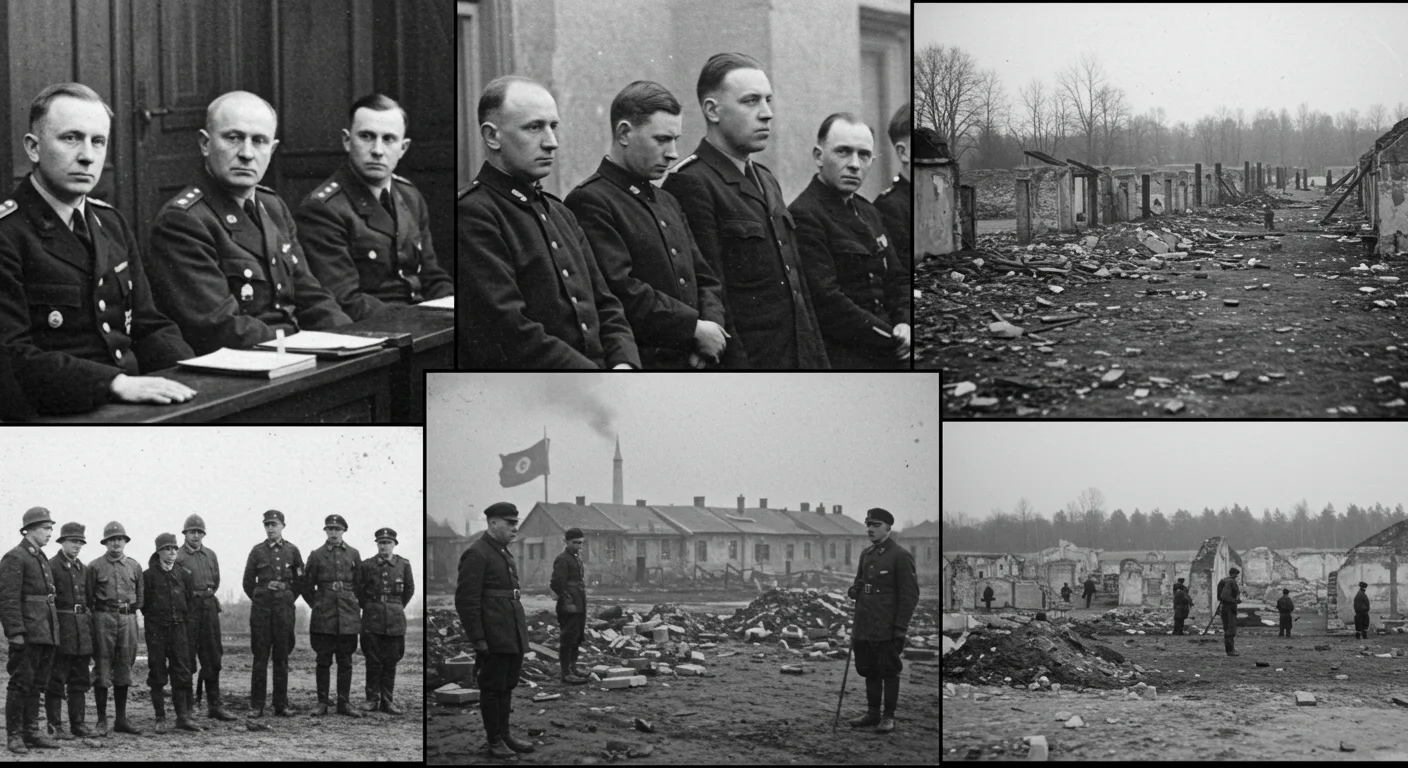
- Riddle: I was the Nazi doctor who conducted cruel experiments at Auschwitz. Who am I?
Hint: My name is synonymous with medical atrocities.
Answer: Josef Mengele
- Riddle: I was the Japanese unit that conducted biological experiments in China. What am I?
Hint: My number is 731.
Answer: Unit 731
- Riddle: I was the 1944 massacre of Polish prisoners by the SS in Warsaw. What am I?
Hint: It occurred during an uprising.
Answer: Wola Massacre
- Riddle: I was the Nazi official tried at Nuremberg who oversaw the Final Solution. Who am I?
Hint: My name is Adolf Eichmann.
Answer: Adolf Eichmann
- Riddle: I was the 1942 massacre of Czech villagers after an assassination. What am I?
Hint: My name is Lidice.
Answer: Lidice Massacre
- Riddle: I was the trial of Nazi leaders in a German city, setting legal precedents. What am I?
Hint: I’m named after my location.
Answer: Nuremberg Trials
Additional Miscellaneous
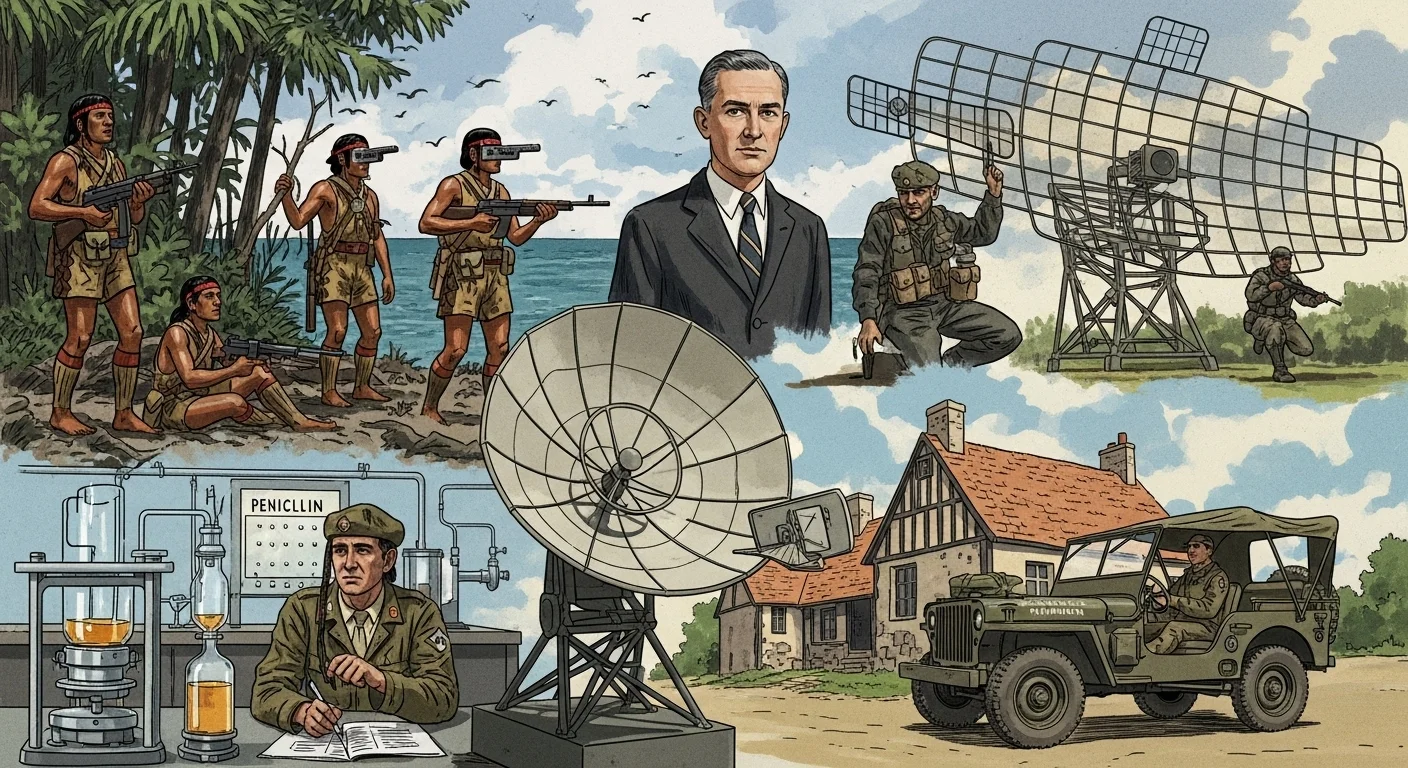
- Riddle: I was the U.S. code talkers who used their native language to secure communications. Who am I?
Hint: My language was Navajo.
Answer: Navajo Code Talkers
- Riddle: I was the British scientist who developed radar, aiding the Battle of Britain. Who am I?
Hint: My name is Robert Watson-Watt.
Answer: Robert Watson-Watt
Major World War 2 Battles
The table shown below gives the highlights of major battles mentioned in the riddles, as a background to their relevance.
| Battle | Date | Location | Significance |
| D-Day (Operation Overlord) | June 6, 1944 | Normandy, France | Largest amphibious invasion, liberated Europe |
| Battle of Stalingrad | 1942–1943 | Stalingrad, USSR | Turning point on the Eastern Front |
| Pearl Harbor | December 7, 1941 | Hawaii, USA | U.S. entry into the war |
This table supports the riddles by offering a quick reference for readers, enhancing SEO with structured data.
Conclusion
World War 2 was a multidimensional web of bravery, planning and sacrifice. The World War 2 riddles for kids presented here are a light, but a deep approach to this history both by a kid and adults. Whether it is the leadership of Churchill or the invention of the Enigma machine, everyone of these riddles can show a puzzle of the past.
To get some hints on how to solve a difficult riddle, see our guide to solving riddles like a pro. Bookmark the page, leave your favorite riddles in the comment section and keep studying the lessons of history with websites such as the Imperial War Museums.
Frequently Asked Questions (FAQs)
What are some WWII questions?
Common World War 2 questions include:
When did the war start and end? (1939–1945)
What caused the war? (German aggression, Treaty of Versailles)
Who were the key leaders? (Churchill, Hitler, Roosevelt)
What were major battles? (D-Day, Stalingrad)
How did it impact the world? (UN formation, Cold War)
For more insights, visit the United States Holocaust Memorial Museum.
What are 5 interesting facts about WWII?
Over 70 million people died, making it the deadliest conflict ever.
The first computer, Colossus, was built to crack German codes.
The Soviet Union lost over 20 million people, the highest toll.
Women served as pilots, spies, and factory workers, reshaping roles.
The United Nations was founded in 1945 to prevent future wars.
Explore more facts at History.com’s WWII section.
What is World War 2 nicknames?
World War 2 was called:
The Second World War
The Great Patriotic War (Soviet Union)
The Good War (United States)
What are the essential questions of WW2?
Essential questions include:
How did the war begin?
What were its turning points?
How did technology shape warfare?
What was the civilian role?
How did it influence the post-war world?
For more historical riddles, try our American history riddles or learn about another war with our India vs Pakistan war riddles.